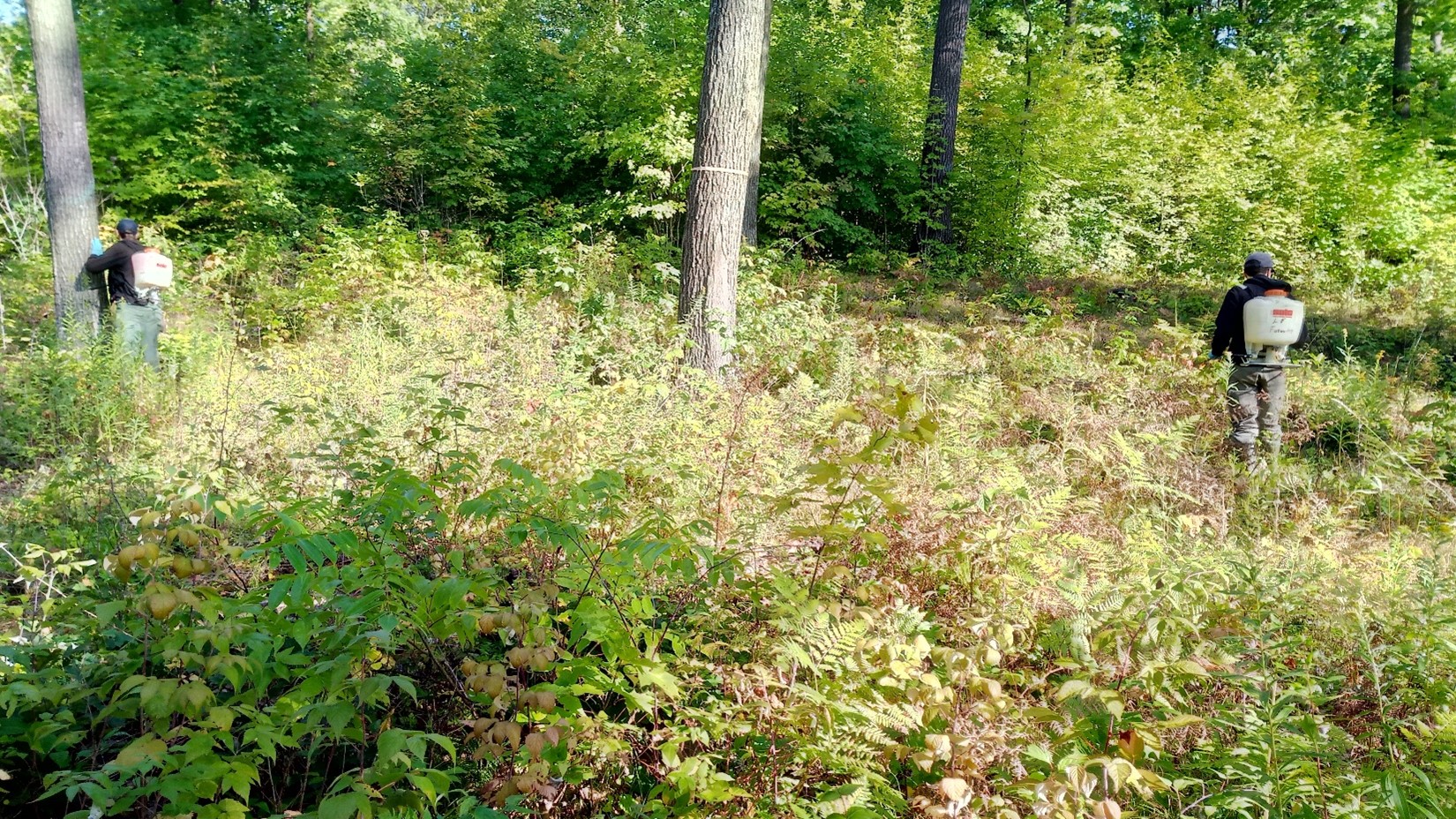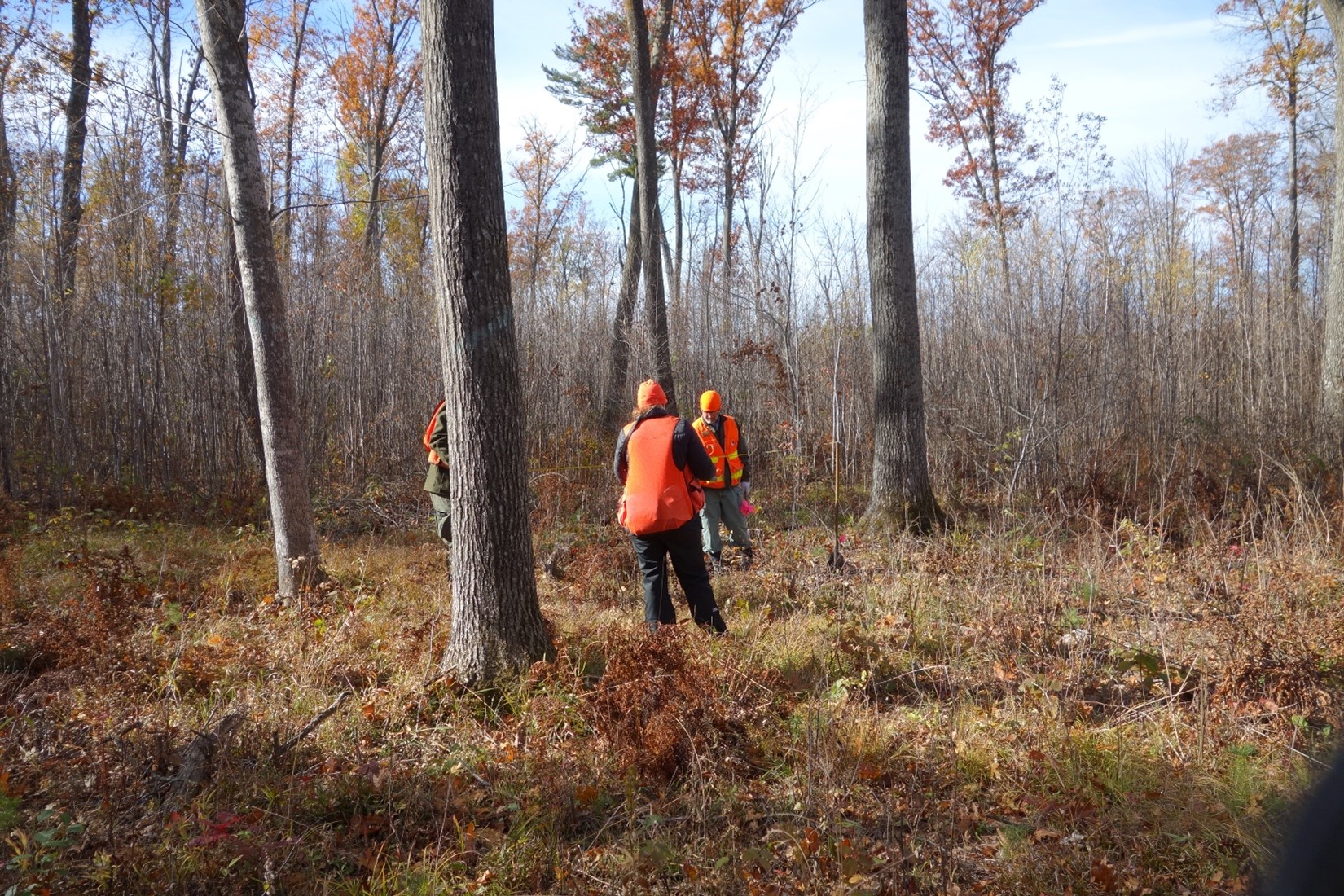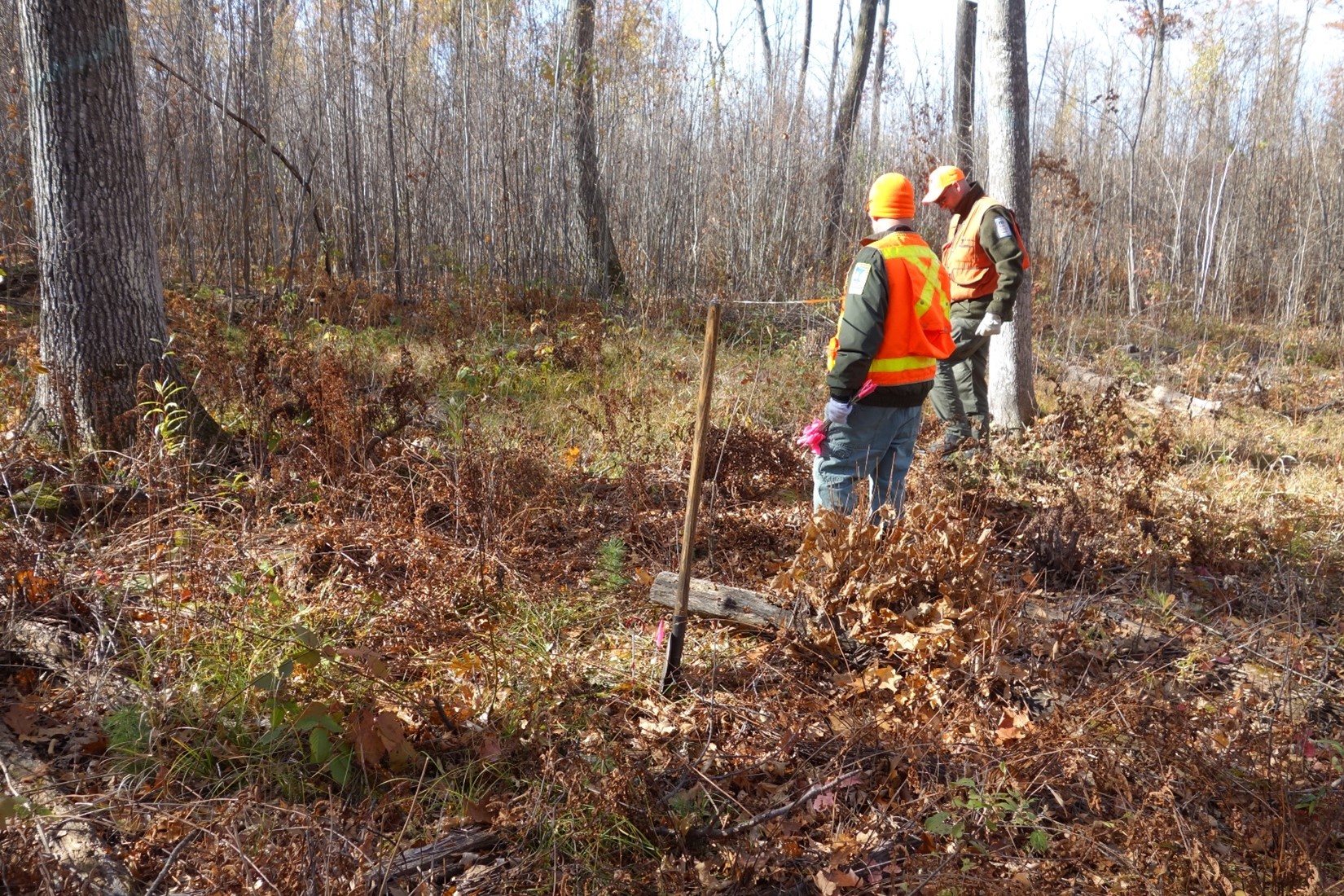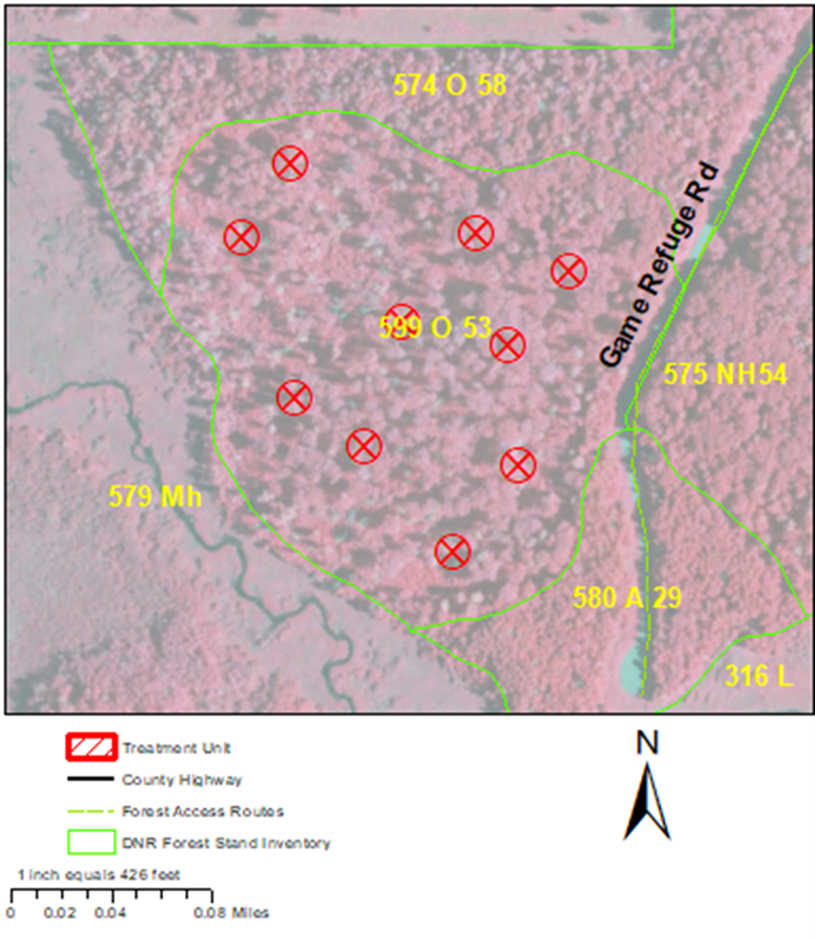Overview
The focus of this in-progress case study is to document and provide early results of a field trial to determine if small group or cluster plantings of white pine will be more successful and less expensive than the two most common reintroduction methods in the Rum River State Forest and Mille Lacs Wildlife Management Area (WMA). These methods have been:
1. planting in pure stands, or
2. interplanting with natural hardwood regeneration
For comparison purposes, we also document conditions for 2 nearby sites that had white pine interplanted throughout the stand with natural hardwood regeneration.
Although white pine was historically a common canopy component in the common NPCs in Mille Lacs County, attempts to reintroduce it over the years by planting in pure stands, or by interplanting with natural hardwood regeneration, have had mixed success. Challenges have included poor recruitment, blister rust, and deer browse.
White pine seedlings were planted at 1000 trees per acre within 10, 1/10th acre clusters in the case study stand. Bud capping and pruning will be implemented as needed. The intent is that by grouping the trees, fewer trees will get missed during tending work such as pruning and budcapping, blister rust observations will be easier and more thorough, and therefore treatment can be more rapid, effective, and less expensive.
Silviculture Objectives
- Establish a robust, self-sustaining component of white pine as part of the overall regeneration strategy for a mature mesic hardwood stand.
- Perform a field trial of a group or “cluster” white pine planting and tending strategy to improve tending effectiveness and lower costs, as opposed to planting throughout the site.
- Improve species diversity and climate resilience of stand.
Pre-treatment stand description and condition
Stand establishment and management history
1974 aerial photos show a closed-canopy forest. The site had the first cut of a shelterwood harvest in the winter of 2012-13.
Pre-treatment species composition
Prior to the 2012/13 first stage shelterwood harvest, the mature stand was a fully stocked oak forest type stand containing a mixture of species, with the greatest volumes in red oak, basswood, bur oak and maple.Birch, ash, and white pine also present but scattered.
In 2021—immediately prior to the case study silvicultural treatments—overstory stand condition was about 55 ft2/acre basal area of mostly red oak and some basswood, with an average 14 inch DBH.
Landowner objectives/situation
While specific objectives vary from parcel to parcel, lands under the administration of DNR-Forestry are managed in alignment with Section Forest Resource Management Plans (SFRMP) to ensure that state forest management activities meet statewide goals for ecological protection, timber production, wildlife habitat and cultural/recreational values. The DNR assembles teams from the Divisions of Forestry, Fish & Wildlife, and Ecological & Water Resources who work with partners and the public to develop SFRMPs.
A specific objective for white pine management in the Mille Lacs Uplands Section Forest Plan is to increase the amount of white pine in the subsection by 100 percent over 2002 levels.
Note: Historically, white pine most often occurred as a component in other forest types rather than as a pure type. It is most successfully introduced in stands with some residual overstory; therefore, reaching this goal may not actually effect a significant change in the number of acres of white pine cover type.
Silviculture prescription
The following series of treatments were implemented:
Treatment | Date | Description | Acres |
Silvicultural assessment | 1/12/2012 | The stand was field-visited to assess the need for silvicultural treatment and strategy. The prescription was designed to limit the transition to maple, maintain oak, and re-establish white pine. | 18.2 |
Shelterwood harvest | Winter of 2012/2013 | First stage shelterwood establishment harvest.
| 18.2 |
Mechanical-chemical site preparation | June 2020
September 2021 | GPS points were established at 10 randomized, 1/10th acre circular patches (clusters) spread throughout the site. Plot centers were at the nearest mature residual tree to each GPS point. Brush was cleared in each circular patch using brush saws and chain saws. Herbicide Garlon 3A (triclopyr) at 4 qts./acre was broadcast-applied to the cleared areas using backpack sprayers. Forestry staff was used for labor. The herbicide application took 1 day to complete. | 1 |
Planting | Spring 2022 | Hand plant 1000 stems of bareroot 3-0 white pine seedlings at approximately 6’ X 7’ spacing (1,000/acre) in the 10 cleared areas (clusters). | 1 |
Bud capping | November 2022 | Terminal buds of planted white pine were protected from deer browse with paper budcaps. | 1 |

Figure 1: Forestry staff apply herbicide in a cluster as site preparation in September 2020
What actually happened during the treatment
Things largely went as planned, with the exception that 1 of the prepared clusters inadvertently did not get planted. However, we had the good fortune that the unplanted cluster got natural seeding from an adjacent large residual white pine tree, so natural white pine seedlings have become established in that cluster.
Post-treatment assessment
It’s early, but so far, so good
The main objective of the cluster planting strategy is to achieve a white pine component through improved survival and recruitment, compared to planting throughout the site. The hope is that by clustering the trees, fewer trees will get missed during tending work such as pruning and budcapping, blister rust observations will be easier and more thorough, and therefore treatment can be more rapid, effective and less expensive.
Obviously it is early and we will need to monitor over time, but so far so good after 1 year on improved survival. As shown in Table 1 and Figure 2, survival and health of the white pine seedlings as of October 2022 was excellent. Competing vegetation was still well-controlled.
These are very early results of course, so we look forward to closely monitoring costs and effectiveness into the future until white pine seedlings are “free-to-grow”. The significant test will be after white pine seedlings get above snow cover and are more exposed to deer browse during heavy browse potential seasons.
Table 1: October 2022 white pine regeneration check results on case study site
Condition | Stems/Acre | Average Height (Feet) | Frequency on Plots |
Live Healthy White Pine | 950 | 1 | 100% |
Dead White Pine | 20 | NA | 17% |
Live Browsed White Pine | 7 | 1 | 7% |
Live “Other Damage” White Pine | 13 | 1 | 13% |
Total live stems/acre | 970 |
|

Figure 2: A healthy planted white pine seedling after 1 growing season, October 2022

Figure 3: Forestry staff collect white pine regeneration data in a planted cluster October 2022

Figure 4: Conditions in a prepared and planted cluster (foreground) and heavy aspen regeneration in adjacent uncleared areas (rear of photo) October 2022
Comparison Sites
We gathered data in the spring of 2023 on 2 sites with a traditional prescription of planting 300 white pine/acre throughout the entire site because we want to compare results to the cluster planting strategy over time. Comparison sites were planted in 2013, so the planted seedlings had 10 growing seasons as of April 2023.
White pine survival has been very poor, and the few surviving stems are in poor condition, with a sparse live crown and a significant amount of overtopping competing vegetation (Table 2, Figure 5 and Supplemental figure 1). Forester recollection is that most of the damage was from one severe browsing season in 2016/17. We think that very few, if any of these are likely to recruit to larger size classes.
Table 2: April 2023 white pine regeneration check results on 2 comparison sites where white pine was planted throughout the site
Condition | Stems/Acre | Average Height (Feet) | Frequency on Plots |
Live Healthy White Pine | 9.5 | .8 | 9.5% |
Dead White Pine | 0 | NA | 0% |
Live Browsed White Pine | 19.0 | 3.2 | 14.3% |
Live “Other Damage” White Pine | 0 | NA | 0% |
Total live stems/acre | 28.6 | 2.4 | 23.8% |

Figure 5: A severely browsed and overtopped white pine seedling after 11 growing seasons on 1 of the comparison sites, April 2023
Plans for Future Treatments
Annual bud capping until white pine is free to grow. This typically takes 5 to 10 years.
Release from vegetative competition as needed. This will likely consist of 1 or 2 brush saw release practices over the next 10 years.
Annual monitoring for white pine blister rust during regeneration/bud-capping checks. After the trees are over 3 to 4 feet high, prune the lower 40% of the crown.
Costs and economic considerations
Case study site – white pine planted in clusters distributed across the site totaling 1 acre
Table 3: Treatment costs for white pine cluster planting
White pine cluster planting treatment costs as of 11/2022 (2022 dollars) | ||
Treatment | Cost for the single treated acre | Cost/acre when costs are distributed over the entire 18.2 acre stand |
Mechanical site preparation | $1,200 | $65.93/acre |
Herbicide site preparation | $ 850 | $46.70/acre |
Hand plant 1,000 white pine seedlings | $ 380 | $20.88/acre |
Bud-capping fall 2022 | $ 26 | $1.43/acre |
Total cost | $ 2,456 | $134.94/ac. |
Comparison sites - traditional white pine plantings of entire site at 300 seedlings/acre
Table 4: Treatment costs for traditional entire site white pine planting, stand T04026w1330600
White pine entire site planting treatment costs for FIM stand 600 as of 11/2022 | |
Treatment | Cost/acre |
Hand plant 300/ac. white pine seedlings | $ 176/ac. (2013 dollars) |
Bud-capping fall 2013 | $ 31/ac. (2013 dollars) |
Bud-capping fall 2015 | $ 42/ac. (2015 dollars) |
Bud-capping fall 2014 | $ 40/ac. (2014 dollars) |
Brushsaw release 2015 | $ 115/ac. (2015 dollars) |
Bud-capping fall 2017 | $ 42/ac. (2017 dollars) |
Brushsaw release 2017 | $ 75/ac. (2017 dollars) |
Bud-capping fall 2018 | $ 30/ac. (2018 dollars) |
Bud-capping fall 2019 | $ 24/ac. (2019 dollars) |
Bud-capping fall 2020 | $ 24/ac. (2020 dollars) |
Total costs | $ 599/ac. |
Table 5: Treatment costs for traditional entire site white pine planting, stand T04026w133598
White pine entire site planting treatment costs for FIM stand 598 as of 11/2022 | |
Treatment | Cost/acre |
Hand plant 300/ac. white pine seedlings | $ 220/ac. (2013 dollars) |
Bud-capping fall 2013 | $ 35/ac. (2013 dollars) |
Bud-capping fall 2014 | $ 38/ac. (2014 dollars) |
Brushsaw release 2015 | $ 115/ac. (2015 dollars) |
Bud-capping fall 2015 | $ 40/ac. (2015 dollars) |
Bud-capping fall 2016 | $ 40/ac. (2016 dollars) |
Bud-capping fall 2017 | $ 40/ac. (2017 dollars) |
Bud-capping fall 2019 | $ 28/ac. (2019 dollars) |
Bud-capping fall 2020 | $ 28/ac. (2020 dollars) |
Total costs | $ 584/ac. |
Costs per acre were about 70% lower for the cluster planting site after 1 year
In addition to the main objective of improved white pine survival and recruitment, a second important objective of cluster planting was to see if we could reduce costs compared to planting throughout the site. So far, so good on that as well. If we compare costs for both strategies after 1 year (the same period of time in their establishment history), we see that:
- The cluster planting has cost $134.94/acre after planting and 1 bud-capping
- The entire site plantings averaged $231.00/acre after planting and 1 bud-capping
Therefore, at a comparable early stage after 1 year, costs/acre for establishing a white pine component across the site were $ 96.06/acre lower for the cluster planting than for the entire site plantings. This amounts to about a 70% reduction in per-acre costs so far.
Notes on comparing costs:
Because the objective was to establish a white pine component distributed across the hardwood stand, we think the best “apples to apples” cost assessment methodology for comparing the cluster planting to traditional entire site planting is to distribute costs for the cluster planting across the entire 18.2 acre site. For example, even if 30 trees in each of the clusters (300 total across the 18.2 acre site) were to reach “free-to-grow” status, this would meet our objective of establishing a white pine component spread across the site. We plan to continue monitoring these sites and comparing costs over time.
As we continue to monitor these sites over time, we could also compare cost/tree recruited into larger size classes. If we get even fair recruitment for the cluster planting, cost/tree would be considerably lower for that than on the traditional entire site plantings. This is largely because there will be very few, if any white pine that recruit to larger size classes on the comparison sites (Table 2).
Other notes
Impact of a white pine component to stand resilience for forest health threats
Including a white pine component will improve species diversity of the stand. Establishing a diversity of species that are a good ecological fit is an important strategy for improving stand resiliency to potential future forest health issues.
White pine and climate change in the MHc36 Native Plant Community
In the MHc36 NPC, white pine is rated as a good crop tree. It is rated as stable under a wetter climate scenario, with a rating of significant decrease for a warmer climate scenario. See Table 6.
Table 6: White pine crop tree rating, and response to two climate change scenarios, in the MHc36 plant community
Crop tree potential | Response to warmer climate | Response to wetter climate | |
White pine | Good | Significant decrease | Stable |
We think including white pine as a strategy for providing additional diversity to this stand makes sense because:
- Doing so is an objective in the current Section Forest Resources Management Plan.
- It is rated as a good crop tree in this native plant community.
- It will help improve stand resiliency to potential future forest health issues.
- It is a species with a historical presence in this stand and region.
- It is projected with a stable rating under a wetter climate scenario.
However, the rating of significant decrease for white pine under a warmer climate scenario is a cautionary factor that needs to be considered. We think the strategy of including white pine as a somewhat modest component, rather than as a dominant species, helps to mitigate this concern. We are also mindful that while a warmer climate is projected to be the most likely climate scenario, there is uncertainty around this. We also think it important to note that the analysis showing white pine’s crop tree rating decreasing in a warmer climate did not consider impacts of white pine blister rust, which is a major tree health and mortality consideration for white pine. There is evidence that warmer temperatures reduce infection rates of white pine blister rust, which could reduce future mortality from that specific cause under a warmer climate scenario. Source: Environment in Relation to White Pine Blister Rust Infection, Van Arsdel, Texas A&M University.
On balance, we think the benefits of including white pine as a component in this stand outweigh the concern of a projected significant decrease in crop tree rating in the most likely climate scenario of a warmer climate.
We had help with this study
We gratefully acknowledge the data-gathering assistance of MNDNR Central Region Forestry Manager Bob Milne, and the case study review and editing assistance of MNDNR Silviculture Program Coordinator Mike Reinikainen.
Summary
Survival and health of the white pine seedlings in planted clusters as of October 2022 was excellent
The main objective of the cluster planting strategy is to achieve a white pine component through improved survival and recruitment, compared to planting throughout the site. Obviously, it is early and we will need to monitor over time, but after 1 year we observed improved survival. As shown in Table 1 and Figure 2, survival and health of the white pine seedlings as of October 2022 was excellent. Competing vegetation was still well-controlled.
Costs per acre were about 70% lower for the cluster planting site after 1 year compared to the traditional strategy of planting the entire site
These are very early results. We plan to continue monitoring treatment costs and effectiveness into the future and share results until white pine seedlings are “free to grow”
Things look promising so far, but the major test of effectiveness will come later, after the white pine seedlings get above annual snow cover, and are exposed to deer browse during heavy browse potential seasons. We plan to periodically update this study over time, so stay tuned.
Supplemental content

Supplemental figure 1: 2018 Minnesota DNR Field Tour Notes: Management History and Stand Condition Observations for Case Study Comparison Sites – FIM Inventory Stand #598 and #600
